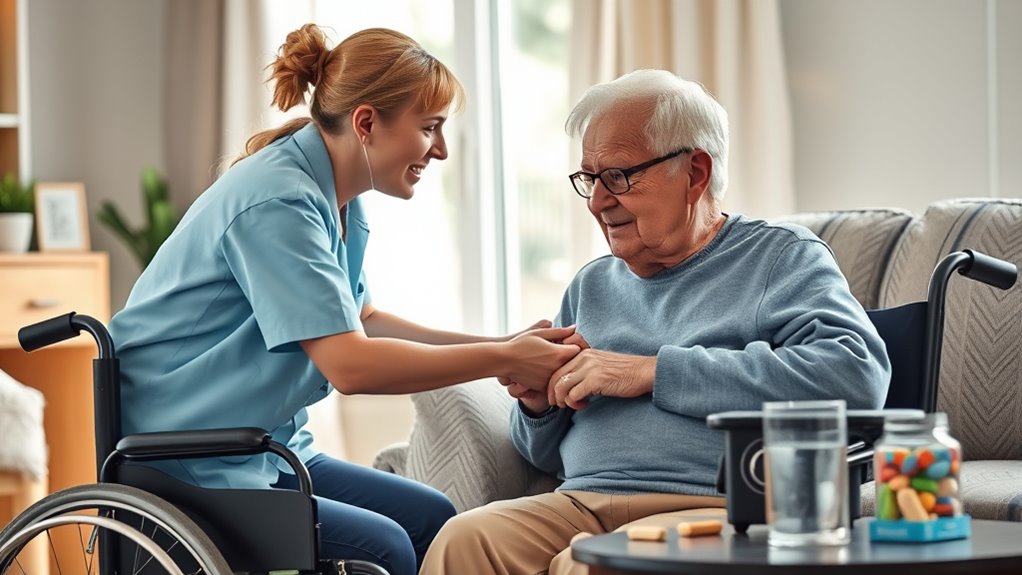Caring for Parkinson’s disease involves understanding its causes, undergoing thorough diagnosis, and exploring both medication and advanced treatments like deep brain stimulation. You can improve daily life through physical and occupational therapy, proper nutrition, and safety precautions. Managing symptoms and emotional well-being is essential, along with support networks for long-term care. Staying informed about new therapies and environmental factors can make a difference. Keep exploring to learn how you can create an effective Parkinson’s care plan tailored to your needs.
Key Takeaways
- Implement personalized medication management, including levodopa and dopamine agonists, to control symptoms and minimize side effects.
- Engage in regular physical, occupational, and speech therapies to maintain mobility, independence, and quality of life.
- Modify the home environment with safety features like grab bars and remove hazards to prevent falls and injuries.
- Monitor environmental exposures and advocate for ongoing research to understand and reduce toxin-related risks.
- Incorporate emerging technologies such as AI diagnostics and advanced surgical options like Deep Brain Stimulation for comprehensive care.
Understanding Parkinson’s Disease: Causes and Symptoms
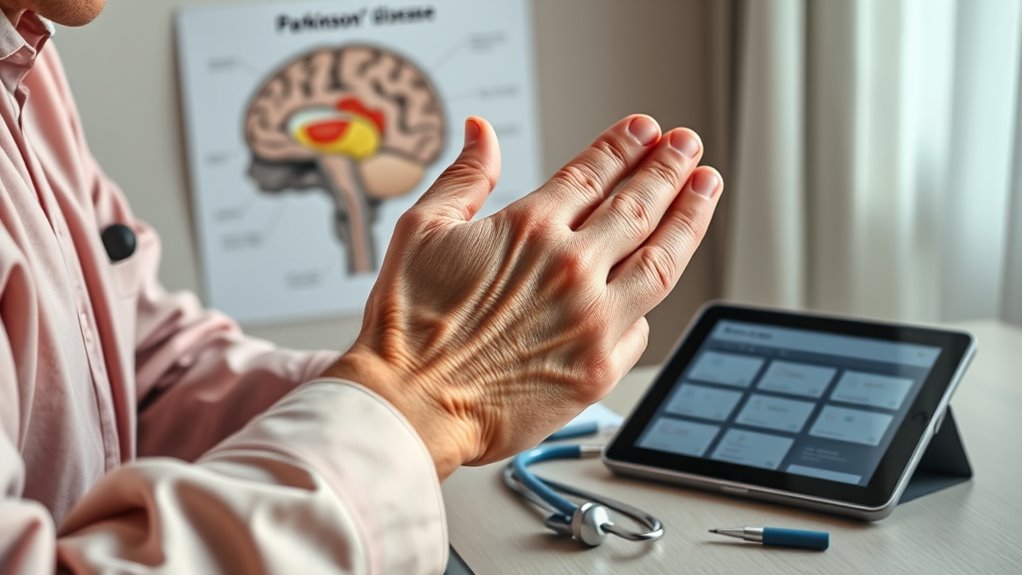
Parkinson’s disease is a progressive neurological disorder that primarily affects movement. While the exact cause remains unknown, both genetic factors and environmental influences play significant roles. You might inherit certain gene mutations that increase your risk, especially if there’s a family history. However, genetics isn’t the sole factor; exposure to environmental toxins like pesticides or heavy metals can also contribute to developing the disease. These influences may trigger changes in brain cells, particularly in the substantia nigra, leading to dopamine loss. Recognizing that a combination of genetic predisposition and environmental exposures can cause Parkinson’s helps you understand why some people develop it while others don’t. Being aware of these factors can also guide you toward early detection and potential lifestyle adjustments. Additionally, understanding environmental toxins can help you learn more about managing symptoms and improving quality of life. Increased research into toxin exposure continues to shed light on preventative strategies and treatment options for the disease. Furthermore, understanding the cycle of neurodegeneration can assist in developing targeted therapies to slow disease progression. For example, studying the interactions between genetics and environment may provide insights into personalized treatment approaches.
Diagnosing Parkinson’s: What to Expect During Evaluation

When you visit your doctor for a Parkinson’s evaluation, they’ll review your medical history and ask about your symptoms. You can expect a series of tests to assess your movement, balance, and coordination. These procedures help your doctor determine whether your symptoms align with Parkinson’s disease or another condition. Additionally, they may consider financial factors as part of their assessment to understand factors that could influence your diagnosis. Furthermore, your healthcare provider might evaluate symptom progression to better understand the disease stage and tailor your care plan accordingly. Incorporating AI-driven diagnostics can also aid in more precise assessments, especially by analyzing subtle motor changes over time. Being aware of potential financial aspects can also help in planning for ongoing treatment costs and support services.
Diagnostic Procedures Overview
Diagnosing Parkinson’s disease involves a thorough evaluation process that helps your healthcare provider determine the best course of action. You may undergo brain imaging, such as MRI or DaT scans, to rule out other conditions and assess dopamine levels. Laboratory tests can also be ordered to check for underlying issues or to exclude other illnesses with similar symptoms. These tests don’t confirm Parkinson’s directly but provide valuable information to support your diagnosis. Your doctor will evaluate your neurological function through physical exams and may use specialized tools to observe movement patterns. Additionally, participating in remote hackathons can foster collaboration among healthcare professionals and researchers working on Parkinson’s disease. Incorporating comprehensive diagnostic procedures can enhance the accuracy of diagnosis, ensuring that treatment plans are appropriately tailored to your condition. Utilizing advanced imaging technology can further improve diagnostic precision, especially in early-stage Parkinson’s. Implementing standardized assessment tools can also help track disease progression and treatment effectiveness over time. Leveraging cybersecurity measures in healthcare technology can also help protect sensitive patient data during diagnostic evaluations. This extensive approach ensures an accurate diagnosis, helping you and your healthcare team develop an effective management plan tailored to your needs.
Symptoms and Medical History
Your healthcare provider will begin by asking about your symptoms and medical history to build a clear picture of your condition. They’ll inquire about any tremors, rigidity, or slow movements you’ve experienced, as well as your overall health and family history. They may also consider genetic markers that could increase your risk for Parkinson’s. Environmental factors, such as exposure to pesticides or toxins, are also relevant. You might be asked about water-related environmental exposures that could be linked to neurodegenerative conditions. Your provider might ask about lifestyle habits and environmental exposures to identify potential triggers. This information helps determine if your symptoms align with Parkinson’s or suggest other conditions. By gathering detailed history, they can better decide on next steps, including diagnostic tests or referrals, to confirm the diagnosis and plan appropriate treatment. Understanding neurobiological factors can further aid in assessing your risk and tailoring your care plan. Additionally, examining air and water quality may provide insights into potential environmental influences on your health. Gathering data on neurochemical imbalances can also assist in evaluating disease progression and treatment options. Moreover, exploring environmental toxin exposure may help identify preventable risk factors associated with neurodegeneration.
Medical Treatments and Medication Management

Understanding your medication options is key to managing Parkinson’s symptoms effectively. You’ll learn how different treatments work and what effects to expect. Managing potential side effects is also an important part of your medication plan. Being aware of medication management strategies can help optimize treatment outcomes and minimize adverse effects. Incorporating personal growth and wellness principles, such as reflection and seeking feedback, can enhance your overall approach to health management. Additionally, consulting with healthcare providers about regulatory changes impacting medication availability can ensure you stay informed about the latest guidelines and safety measures. Staying updated on appliance innovations related to medical devices can also support better management of your condition. Incorporating knowledge about traditional and modern treatment techniques can further aid in comprehensive care planning.
Medication Options and Effects
Medications are central to managing Parkinson’s disease symptoms, helping to improve quality of life and maintain mobility. Common options include levodopa, dopamine agonists, and MAO-B inhibitors. These drugs can effectively reduce tremors, rigidity, and bradykinesia, but they may also lead to drug interactions if combined with certain foods or other medications. It’s essential to discuss all medications with your healthcare provider to avoid complications. Some patients explore alternative therapies like physical therapy, acupuncture, or nutritional adjustments to complement medication effects. Here’s a quick overview:
| Medication Type | Benefits | Considerations |
|---|---|---|
| Levodopa | Most effective for symptoms | May cause dyskinesia, drug interactions |
| Dopamine Agonists | Fewer motor fluctuations | Sleep issues, impulse control problems |
| MAO-B Inhibitors | Extend levodopa effects | Potential interactions with certain foods |
| Anticholinergics | Reduce tremors | Side effects like dry mouth, confusion |
| Alternative Therapies | Complement symptom management | Consult with your doctor before trying |
Managing Side Effects
Managing side effects is a key aspect of effective Parkinson’s disease treatment, especially since many medications can cause unwanted reactions. Medication side effects, like nausea, dizziness, or involuntary movements, may seem challenging, but you can learn to cope with tremors and other symptoms more comfortably. Stay in close contact with your healthcare team to adjust dosages or switch medications if side effects become severe. Keeping a symptom journal helps identify patterns and triggers. Regular exercise, stress reduction techniques, and proper nutrition can also reduce side effects and improve quality of life. Remember, managing side effects is an ongoing process, and proactive communication with your doctor ensures your treatment remains effective while minimizing discomfort.
Surgical Options and Advanced Therapies
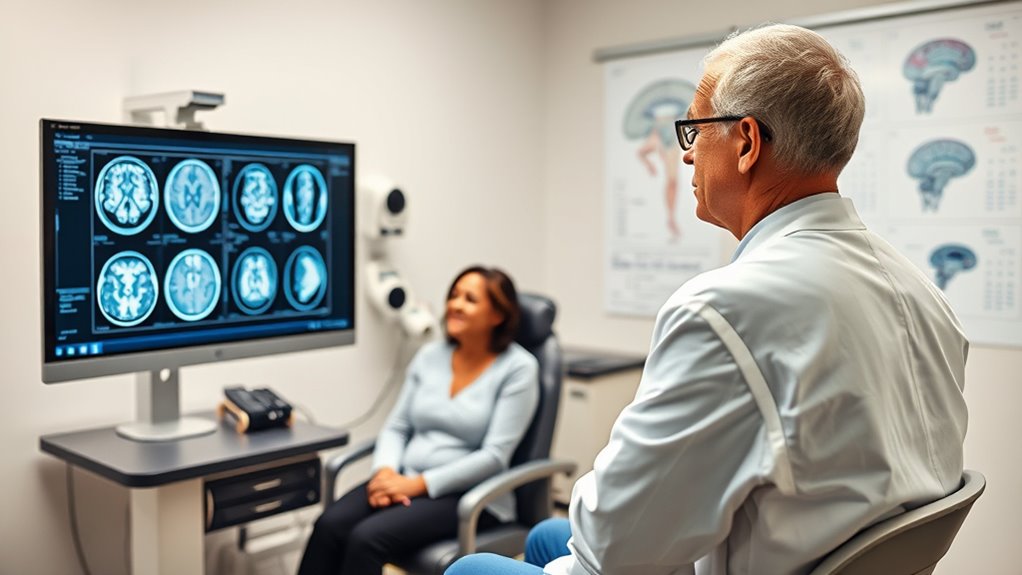
When medications no longer provide adequate symptom control, surgical options and advanced therapies can offer considerable relief. Deep Brain Stimulation (DBS) is a common surgical procedure where electrodes are implanted in specific brain areas to regulate abnormal activity. This helps reduce tremors, rigidity, and motor fluctuations. During the surgery, you’ll be awake but sedated, allowing precise placement of electrodes. DBS can markedly improve quality of life, especially when medication effects wear off. Other surgical procedures, like lesioning, aim to destroy overactive brain regions. These options are typically considered when medication adjustments no longer work effectively. Consulting with your neurologist and neurosurgeon will help you determine if surgical options are right for you, balancing benefits with potential risks.
Physical and Occupational Therapy for Mobility and Independence
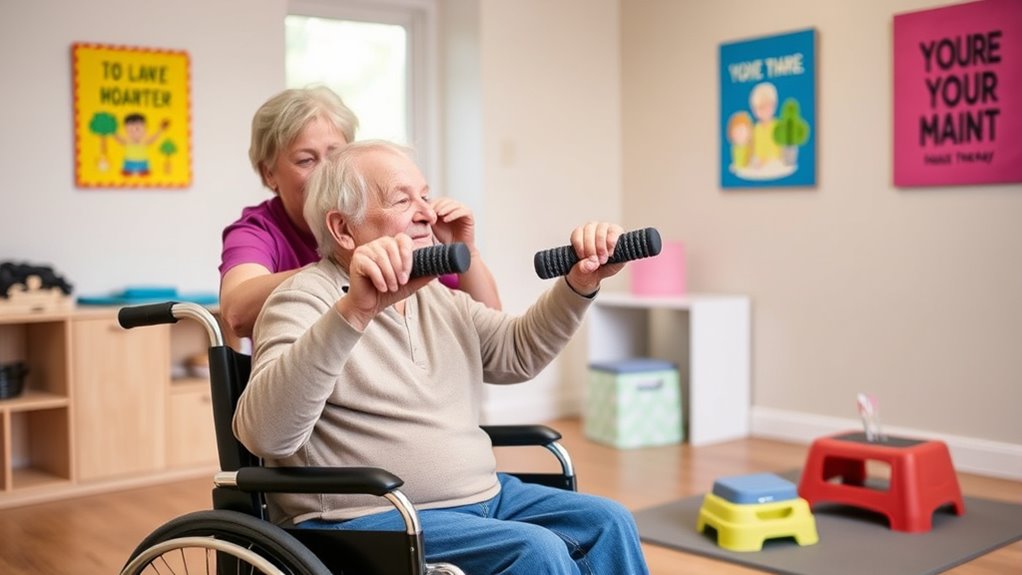
Physical and occupational therapy play a crucial role in maintaining your mobility and independence as Parkinson’s progresses. Through targeted balance exercises, you can strengthen your stability and reduce the risk of falls. Therapists teach you techniques to improve posture and coordination, helping you move more confidently. Occupational therapy focuses on adapting your environment and daily routines to support independence. Using assistive devices like walkers, grab bars, or canes can make everyday tasks safer and easier. Your therapist will recommend the right devices tailored to your needs and teach you how to use them effectively. Regular sessions and consistent practice will help you maintain your abilities longer, empowering you to stay active and independent despite the challenges of Parkinson’s disease.
Nutritional Guidance and Dietary Considerations

Proper nutrition plays a vital role in supporting your overall health and managing Parkinson’s symptoms. Focusing on balanced meal planning helps maintain energy and reduces side effects. Incorporate nutritional supplements if recommended by your healthcare provider to fill dietary gaps. Consistent eating habits can also improve medication effectiveness and reduce gastrointestinal issues.
| Meal Planning Tips | Nutritional Supplements | Foods to Include |
|---|---|---|
| Eat small, frequent meals | Consult your doctor before adding supplements | Fruits and vegetables |
| Include fiber-rich foods | Use supplements to boost nutrients | Lean proteins like chicken or fish |
| Stay hydrated | Ensure supplements don’t interfere with meds | Whole grains |
| Limit processed foods | Follow dosage instructions | Healthy fats like nuts and seeds |
| Maintain regular eating times | Focus on nutrient-dense options | Dairy or alternatives |
Managing Daily Activities and Safety Tips
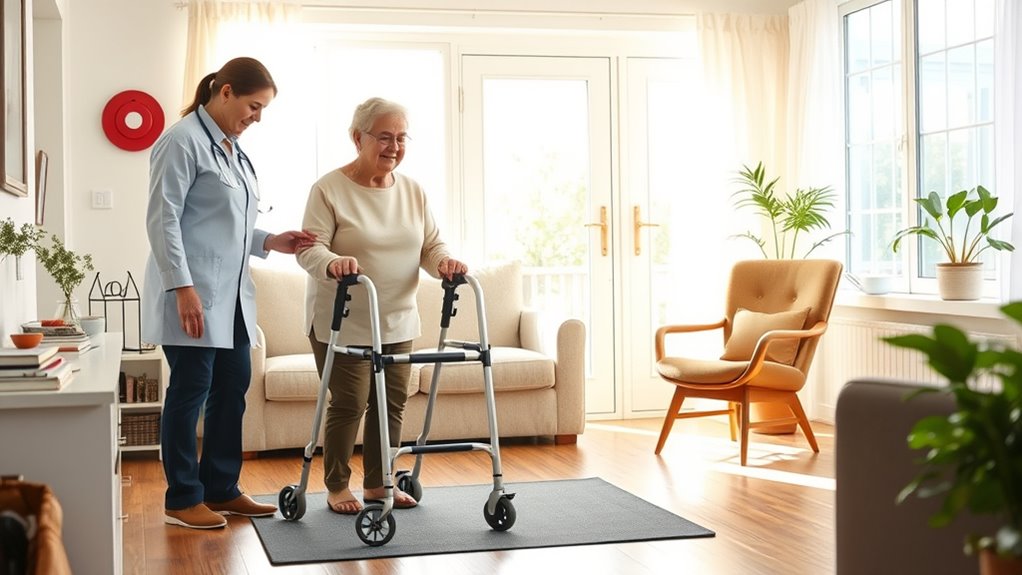
Managing daily activities safely is essential for maintaining independence and reducing the risk of falls or injuries. Using assistive devices like grab bars, walkers, or canes can provide extra stability and support during daily tasks. Home modifications also play a vital role; installing handrails, removing tripping hazards, and ensuring proper lighting make your environment safer. Keep frequently used items within easy reach to avoid unnecessary stretching or bending. Be mindful of uneven surfaces and slippery areas, especially in bathrooms and kitchens. Take your time with activities and avoid rushing. Regularly assess your home for potential hazards and update safety features as needed. These steps help you stay independent longer while minimizing the risk of accidents.
Emotional Well-being and Support Networks

Taking care of your emotional well-being is just as important as managing your daily activities, especially when living with Parkinson’s disease. Building emotional resilience helps you cope with challenges and stay positive. One key step is support group participation, which connects you with others who understand your journey. To strengthen your emotional health, consider these tips:
- Share your feelings openly to reduce stress and foster connections.
- Seek encouragement from peers to boost your confidence.
- Practice mindfulness or relaxation techniques to maintain mental clarity.
Engaging in support networks provides a sense of belonging and reassurance, helping you navigate emotional ups and downs. Prioritizing emotional resilience ensures you stay strong, balanced, and ready to face each day with hope.
Caregiver Resources and Long-term Planning

Planning for long-term care is essential to make certain your loved ones are supported as Parkinson’s progresses. You should explore caregiver resources like respite care, which offers temporary relief so you can rest and recharge. Respite care ensures your loved one continues to receive proper support while preventing burnout. Additionally, participating in caregiver training programs equips you with crucial skills to manage symptoms and navigate daily challenges. These programs help you feel more confident and prepared for future needs. Long-term planning also involves consulting healthcare professionals, understanding legal and financial options, and establishing support networks. By proactively accessing caregiver resources and planning ahead, you ensure your loved one receives consistent care and that you maintain your well-being throughout this journey.
Frequently Asked Questions
How Can I Reduce Parkinson’S Disease Progression Naturally?
To reduce Parkinson’s disease progression naturally, focus on diet modification and staying active. Eat a balanced diet rich in antioxidants, fruits, and vegetables to support brain health. Incorporate regular physical activity, like walking or stretching, to improve mobility and reduce symptoms. Staying consistent with these habits can help slow progression and enhance your quality of life. Remember, consult your healthcare provider before making significant changes to your routine.
Are There Alternative or Herbal Therapies Effective for Parkinson’S?
You might wonder if herbal supplements or alternative therapies can assist with Parkinson’s. While some find benefit in options like turmeric, ginseng, or acupuncture, scientific evidence remains limited. It’s essential to consult your healthcare provider before trying any herbal supplements or alternative therapies, as they can interact with medications and affect your condition. Always prioritize evidence-based treatments alongside any complementary approaches to ensure safety and effectiveness.
How Does Parkinson’S Affect Speech and Communication?
Parkinson’s can make speech and communication tricky, causing your voice to become softer or slurred. You might also find it hard to articulate words clearly. Speech therapy can help strengthen your speech muscles and improve clarity. Using communication aids like speech devices or picture boards can also support your ability to express yourself. These tools and therapies are designed to make conversations easier and help you stay connected with others.
What Are the Early Signs of Parkinson’S in Young Adults?
You might notice early symptoms of Parkinson’s in young adults as subtle changes like tremors, stiffness, or slowed movements. These signs, often called young onset Parkinson’s, can include decreased arm swing, soft voice, or trouble with fine motor skills. If you observe these symptoms, it’s important to consult a healthcare professional promptly, as early diagnosis can help manage the condition and improve quality of life.
How Can Technology Assist With Daily Parkinson’S Management?
Technology can be your guiding light through Parkinson’s daily challenges. Assistive devices and wearable technology act like a caring hand, helping you manage symptoms and stay independent. Devices like smart watches monitor movements and medication reminders, while apps track your progress. These tools empower you to take control, making each day a little easier, like a trusted friend walking beside you. Embrace innovation to brighten your path forward.
Conclusion
Guiding Parkinson’s is like tending a delicate garden—you’ll need patience, care, and the right tools. With the right treatments, support, and a loving hand, you can help your loved one bloom despite the challenges. Remember, you’re not alone on this journey; each step you take is a seed sown for better days ahead. Keep hope rooted deep, and watch as resilience blossoms into strength and courage.
